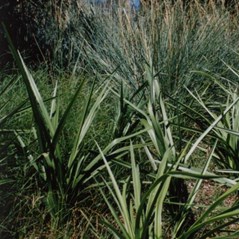Uses: Planted singly or in groups in mixed landscapes as an accent plant, or mass planted, in borders, verges, median strips and roundabouts. Extremely hardy and variable. Good under story plant in sparse or thicker tree plantings. Requires well-drained soils. Attracts native birds and insects.
Cultural use: Indigenous peoples used for making plaited baskets and roots boiled & drunk as medicine.
Caution: Harmful if eaten.
Plant has been found to be fire retardant under certain growing conditions. For further information refer APS Web page: http://www.apsvic.org.au/plant_fire_resistant.html
This plant is indigenous to the following botanical regions of South Australia.
:FR: Flinders Rangers
:NL: Northern Lofty
:MU: Murray
:YP: Yorke Peninsula
:SL: Southern Lofty
:KI: Kangaroo Island
:SE: South Eastern
For detail on these regions refer to the user guide.
- Height 1.2-1.3m
- Spread 0.4-1m
- Position
- Full Sun
- Family Liliaceae
- Botanical Name Dianella longifolia
- Common Name Pale Flax-lily
- Origin SA, Vic, NSW, Qld
- Habit Clumping
- Landscape 2nd line coast, Plains, Footslopes, Hills
- Soil Texture Clay, Loam, Sand
- pH Acidic, Alkaline, Neutral
- Tolerates Lime, Moderate frost, Fire
- Supplementary Watering Minimal
- Flower Colour Blue
- Flowering Time Autumn, Summer
- Flower Type Star
- Purpose Ornamental, Habitat
- Evergreen/Deciduous Evergreen
- Form Grass Sedge or Flax







